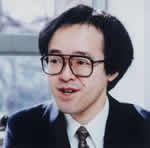Organized Session
| Virtual
Heritage and Virtual Archaeology |
Date: December
3, 2003
Time:
15:20 - 16:40 |
MICHITAKA HIROSE
(The University of Tokyo)
|
 |
Biography:
Michitaka Hirose is a professor of Computer Science at the Research Center for
Advanced Science & Technology(RCAST), the University of Tokyo. His research
interests include human interface, interactive computer graphics, wearable
computer and virtual reality. Currently, he is a project leader of Multimedia
Virtual Laboratory project and Scalable VR Contents project sponsored by
ministry of general affairs. Prof. Hirose received BE, ME and Ph.D. degree
from the University of Tokyo in 1977, 1979 and 1982 respectively. He is a
member of the ACM, IEEE, SICE and VRSJ(Virtual Reality Society of Japan). |
Title:
VR ( Sclable VR Contents ) Project and Virtual
Mayan Ruins
Abstract:
We are currently developing several systems, which consist of different
types of VR technology:
- The theater type VR system with immersive screen and high-resolution
image generator, which can provide VR
environment for many audiences at the same time.
- The home VR system based on PC.
- The mobile/wearable VR system based on mobile computer such as PDA.
The goal of the scalable VR project is to integrate these VR systems into
more sophisticated VR environment.
In my presentation, I will introduce our preliminary implementation
and its content which was exhibited at "Mystery of Maya" of the national
science museum. more than 240,000 square meters of Mayan acropolis ruins
at Copan, Honduras were synthesized in a VR environment by using more than
4000 pictures and 3D geometrical models. Base on the 3D models, the scene
of the acropolis of 1,200 years ago were recreated. Video avatar
technology was used to share the network environment.
Inorder to use this SVR environment, two typical exhibition style, "
GalleryTalk" which mainly uses theater type VR, and "Cooperative
Work" which mainly uses networked home or mobile VR system were prepared.
More than 120,000 people experienced the theater VR system
at the museum, and experiment of "Cooperative Work" was just started
with junior school.
At the end of my talk, I will introduce these experimental results.
KATSUSHI IKEUCHI
(The University of Tokyo) |
 |
Biography:
Dr. Katsushi Ikeuchi is a Professor at the Institute of Industrial Science,
the University of Tokyo. He received the Ph.D. degree in Information
Engineering from the University of Tokyo in 1978. After working at
MIT-AI Lab for three years, ETL for five years, and CMU for ten years,
he joined the university in 1996. His research interest spans computer
vision, robotics, and computer graphics. He has received several awards,
including the D. Marr award for the paper, "Shape-from-interreflection,”
and IEEE R&A K-S Fu memorial best transaction paper award for the
paper, "Toward Automatic Robot Instruction from Perception." He
was General/Program Chairs of several international conferences, including
IROS95(general), CVPR96(Program), ITSC99(general), and ICCV03 (program).
He was a distinguished lecturer of IEEE SP society 2001-2002. He is
Editor-in-Chief of International Journal of Computer Vision. He has
been elected to a fellow of IEEE since 1998. |
Title:
Modeling Cultural
Heritage through observation
Abstract:
This talk presents an overview of our efforts in modeling cultural heritage
through observation. This effort consists of three aspects of research:
geometric, photometric, and environmental modeling. The geometric modeling
creates a complete-consistent surface model from a sequence of partial
views of a heritage object by aligning and merging observed data. The photometric
modeling creates photo-realistic new appearances of a heritage object from
the analysis of its surface. The environmental modeling seamlessly integrates
a virtual heritage object with a real scene by estimating illumination
environment in a real scene. I will overview these component algorithms
developed in my group over the last five years, and, then, explain a project
to construct a multimedia model of the Great Buddha of Nara using these
component algorithms.
NAOTO OKUDE
(Keio University) |
 |
Biography:
職業
慶應義塾大学環境情報学部教授
株式会社オプティマ 代表取締役社長
専門
メディア環境論、コンテンツ・エンジニアリング
学歴
昭和48年4月 慶応義塾大学文学部入学
昭和53年5月 慶応義塾大学文学部社会学科卒業
昭和54年4月 慶応義塾大学院社会学研究科修士課程入学
昭和56年3月 慶応義塾大学院社会学研究科修士課程終了、社会学修士取得
昭和56年4月 慶応義塾大学院社会学研究科博士課程入学
昭和56年9月 米国ジョージ・ワシントン大学院 アメリカ研究科博士課程入学
昭和61年5月 米国ジョージ・ワシントン大学院アメリカ研究科博士課程終了、Ph.D取得
昭和62年3月 慶応義塾大学院社会学研究科博士課程、単位取得退学
職歴・研究教育歴
昭和62年4月 日本女子大学専任講師
平成2年4月 慶応義塾大学環境情報学部メディア環境コース助教授
平成10年4月 慶応義塾大学環境情報学部メディア環境コース教授
現在 慶応義塾大学環境情報学部教授
著作
「アメリカンホームの文化史」住まいの図書館出版局 1988年
「物書きがコンピュータに出会うとき」河出書房新社 1990年
「思考のエンジン」青土社 1991年
「トランスナショナルアメリカ」岩波書店 1991年
「アメリカン・ポップ・エステティックス」青土社 2002年
「『デザイン言語』−感覚と論理を結ぶ思考法」
奥出直人;後藤武【編】 慶応義塾大学出版会 2002年
翻訳
「夢の秘法」ウィリアム・ドムホフ著 奥出 直人;富山 太佳夫訳 岩波書店、1991年
「モダニズム以降のデザイン」ジョン・サッカラ著、奥出 直人;藤原 えりみ;桝山 寛 訳、岩波書店、1991年
|
Title:
Plato's plight and Virtual Reality from a perspective of New Art History
Abstract:
Virtual Reality representation of art will evoke a serious philosophical and
psychological discussion, when we use the virtual reality environment to
examine the possibility to close the gap between sensation and perception.
Story 0: Plato
Plato's plight: once the Real is demarcated, anything else (such as art) becomes
unreal.
Plato's "Real" is a world of non-experiential ideas.
Story 1: Panofsky
Georg Friedrich Hegel once said the course of human history was activated by
a spirit that animates art, no less than science, law or religion, in a precise
and determined way.
Following Hegel, Erwin Panofsky who was Professor of Art History at the Princeton
Institute for Advanced Study stated that the key to the history of artistic
styles was to find expression or manifestation of changing world views.
On this interpretation the art historian's ultimate task is to demonstrate
the dependence of artistic styles on the logic of the development of the human
spirit. He named this approach Iconology. Iconologists have to study various
historical disciplines to cite parallels from philosophy, poetry and all the
other aspects of the past.
When computer software designers come to develop their content, they always
follow the iconologist method and eventually end up to establish links between
individual works of art and stylistic developments in other fields.
Story 2:
Gombrich
E.H.Gombrich wrote Art and Illusion (1960) challenged Panofsky's idea of
art history. If we like to experience the paintings, we need to understand
the
role of sensibility in realistic representation.
The concept of the Real, for Gombridge, exists in an unstable psychological
equilibrium. The Real will slip into the world of illusion and hallucination
and there fantasy and beauty replace truth and knowledge. He developed this
theory by following an early idea of affordance coined by James J. Gibson.
Story 3: Gibson
James J. Gibson was a psychologist of visual perception in general and for
thirty years of his academic research, he had developed his theory toward
a Realist ontology; our visual perception of the world is direct, without
mediation
of any sort. He said simply that there is a real world and we really see
it.
So Gibson was confronted with Plato's plight: once the Real is demarcated,
anything else (such as art) becomes unreal. Plato's "Real" and that
of Gibson are different, but both mentioned an immediate grasp of a "Real" without
any mediating factors. Sensation and percepiton is to be closed in both ways.
KOSUKE SATO
(Osaka University) |
 |
Biography:
Dr. Kosuke Sato is a Professor at Department of Systems Science and Applied
Informatics, Graduate School of Engineering Science, Osaka University.
He received his B.S., M.S. and Ph.D degrees in control engineering
from Osaka University, Japan in 1983, 1985 and 1988, respectively.
He was with the Department of Control Engineering at Osaka University
from 1986 to 1994. Since 1994 he has been with Graduate School of Information
Science, Nara Institute of Science and Technology, where he holds the
rank of Associate Professor. He joined the university in 1999.
He has been a visiting scientist at the Robotics Institute, Carnegie-Mellon
University, PA, from 1988 to 1990. His current interests are in 3D sensing
for Virtual Reality, Human-Computer Interaction and Digital Archives. He
has received several awards, including the Most Influential Paper of the
Decade Award, IAPR Workshop on Machine Vision Applications '98. |
Title:
3D Digitizing and Archaeology
Abstract:
This talk presents an overview in our collaboration of 3D digitizing and
archaeology studies. Firstly, I summarize the relationship between archaeology
study and archaeological methodology on the shape of remained cultural
properties. Then, an traditional visualization method using ink rubbing "TAKUHON" and
computer visualization simulating the same ink rubbing from digitized 3D
data of bronze mirror "DOKYO", bronze bell "DOTAKU" are
presented. Also, it presents a new 3D digitizing system dedicated to capture
the entire shape of a bronze bell which he and his colleagues developed.
The Virtual Reality Society of Japan
The Virtual Reality Society of Japan
Tokyo Crystal Bld. 9F
5-26-4, Hongo, Bunkyo-ku,
Tokyo, 113-0033,
Japan
Tel: +81-3-5840-8777
Fax: +81-3-5840-8766
e-mail: info@ic-at.org
VRSJ Homepage:http://www.vrsj.org/




 Back to ICAT Homepage
Back to ICAT Homepage